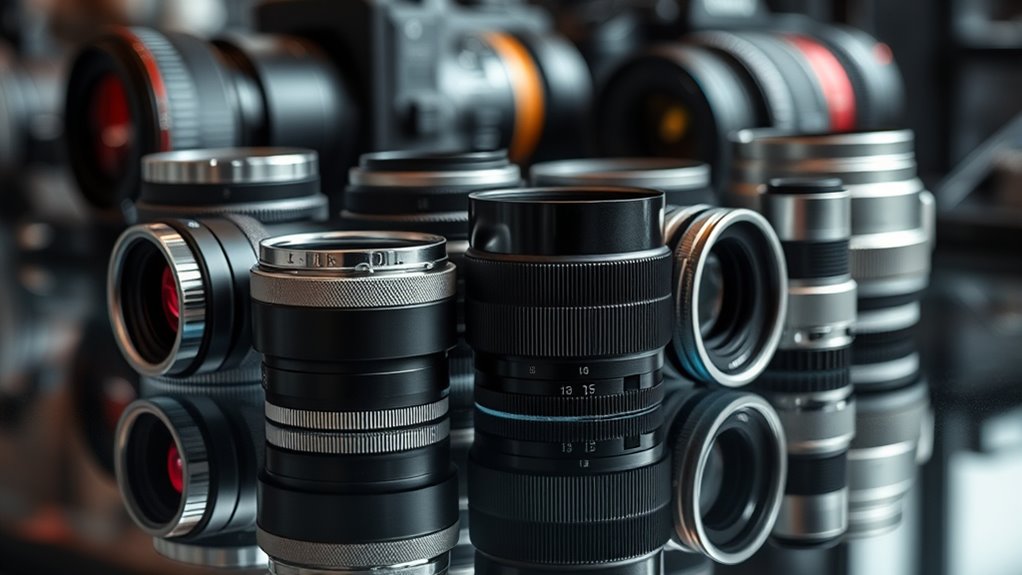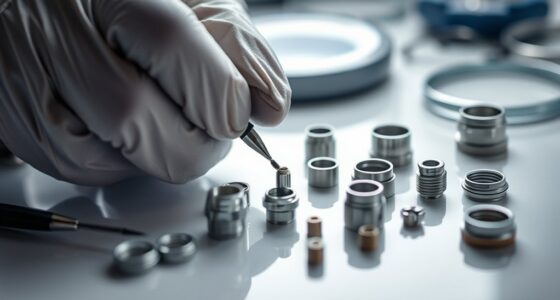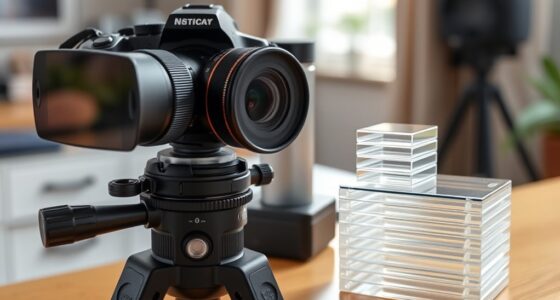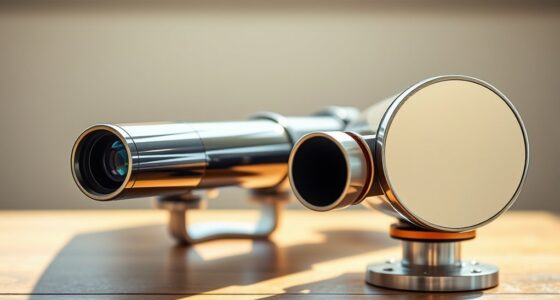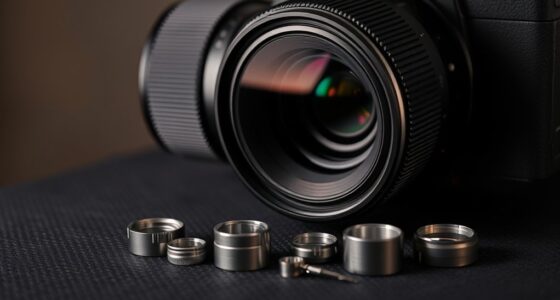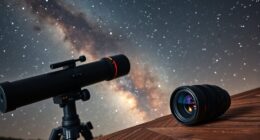Many believe focal reducers and flatteners automatically fix all optical issues, drastically increase your field of view, or always shorten exposure times. They aren’t interchangeable devices, and their performance depends on your specific telescope and camera setup. Higher cost doesn’t guarantee better quality, and these tools don’t eliminate all distortions or need no maintenance. To avoid misconceptions and get the best results, understanding their true limits is essential—keep exploring to learn more.
Key Takeaways
- Focal reducers do not automatically improve all images; optical compatibility is essential to prevent distortions.
- Flatteners correct field curvature but do not reduce focal length or field size; they serve different purposes.
- Residual aberrations like chromatic aberration and vignetting often persist despite using reducers or flatteners.
- Compatibility and proper installation are crucial; using devices outside recommended setups can degrade image quality.
- They enhance optical performance and field of view but do not eliminate all distortions or significantly shorten exposure times.
Focal Reducers Automatically Improve All Types of Images Without Any Drawbacks
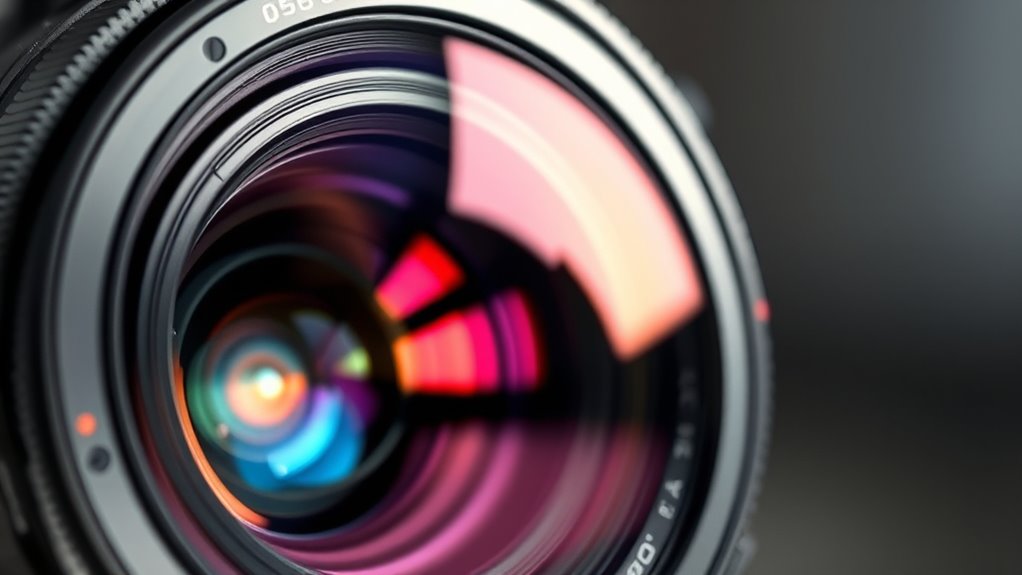
Many people assume that using a focal reducer automatically enhances all types of images without introducing any issues. However, this isn’t always the case. While focal reducers can effectively increase your telescope’s field of view, they can also cause image distortion if not optically compatible with your setup. Poor optical compatibility may lead to issues like coma or aberrations, which degrade image quality. It’s important to choose a focal reducer designed specifically for your telescope’s optics to minimize these problems. Keep in mind that a focal reducer isn’t a one-size-fits-all solution; it can improve some images but might introduce distortions in others if not properly matched. Always verify optical compatibility to ensure your images come out clear and true to life.
They Significantly Increase the Field of View for All Telescopes Equally
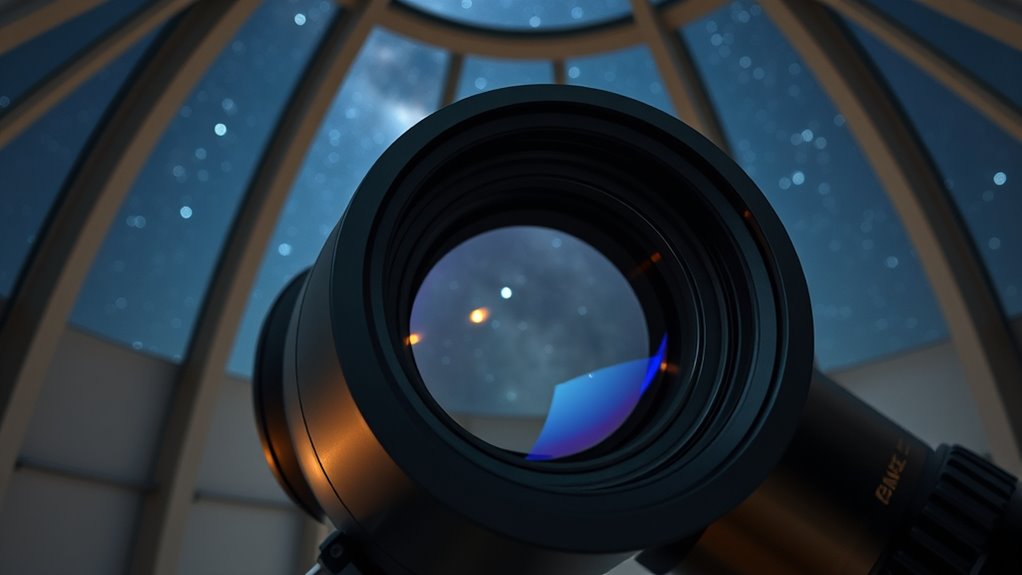
Focal reducers are often praised for their ability to widen your telescope’s field of view, but their impact isn’t the same across all setups. While they do increase the field of view, the extent varies depending on your telescope’s compatibility. Refractors and SCTs typically benefit more from reducers, gaining a noticeably larger field. However, some telescopes with unique optical designs may not show as much improvement or could experience image distortions. It’s important to understand that the degree of field of view increase isn’t universal. Factors like focal length, aperture, and existing optics influence how much a reducer can expand your view. So, don’t assume all telescopes will see the same benefit; check compatibility before expecting a significant increase.
Using a Focal Reducer Will Always Shorten Exposure Times Drastically
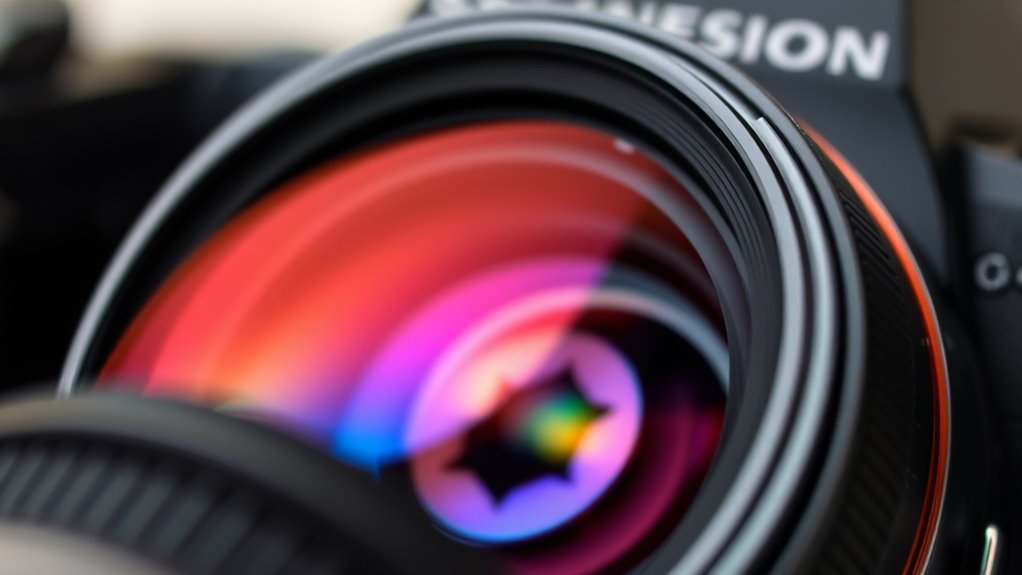
While focal reducers are often marketed as tools that dramatically cut your exposure times, they don’t always deliver those savings in every situation. The reduction in exposure depends on factors like sky conditions, target brightness, and your camera’s capabilities. In some cases, a focal reducer can require longer image processing or additional calibration, offsetting potential gains. Equipment maintenance also plays a role; if your optics aren’t clean or aligned properly, exposure times won’t improve. Additionally, optical performance can influence how effective a focal reducer truly is under different circumstances.
Focal Reducers Are Interchangeable and Work Perfectly With Any Camera or Telescope Combination
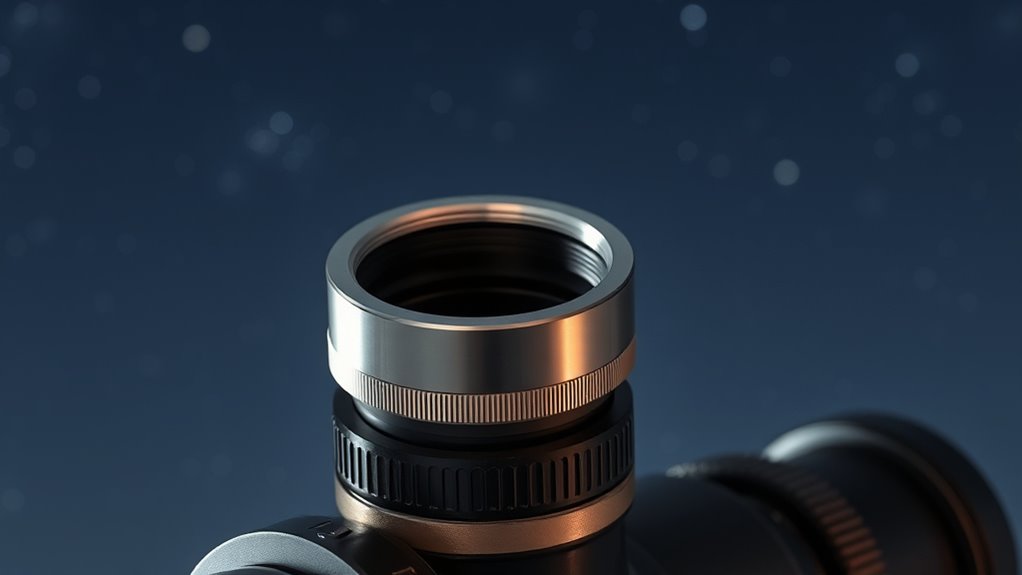
Although focal reducers are designed to be versatile, they don’t work seamlessly with every camera or telescope combination. Different setups can introduce issues like lens distortion or chromatic aberration, which reduce image quality. For example, a reducer tailored for one telescope’s optical design might cause significant distortion when used with another, leading to warped star shapes. Similarly, mismatched camera sensors can amplify chromatic aberration, resulting in color fringing around stars and bright objects. It’s important to check compatibility and consider that manufacturers often recommend specific reducers for particular systems. Relying on a “one-size-fits-all” approach can compromise your images. Instead, select focal reducers designed for your specific telescope and camera combination to minimize aberrations and achieve optimal performance. Optical compatibility is crucial for maintaining image clarity and accuracy.
Flatteners and Reducers Are the Same Device and Can Be Used Interchangeably
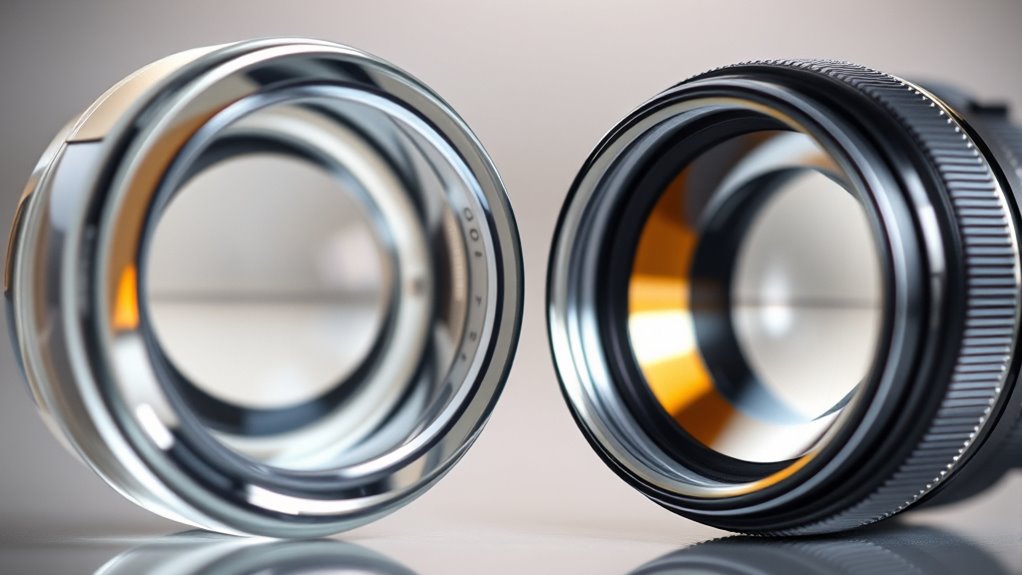
Many people assume that flatteners and reducers are the same device and can be used interchangeably, but this isn’t the case. Flatteners are designed to correct field curvature, ensuring the image remains sharp across the entire focal plane. Reducers, on the other hand, decrease the focal length, giving you a wider field of view or faster optics. Using a flattener as a reducer won’t effectively change your focal length or field size, and vice versa. Proper optical alignment is vital when installing either device to maintain image quality. While both modify the optical system, their functions are distinct, and mixing them up can lead to subpar results and confusion about your telescope’s focal length and image sharpness. Always choose the device suited for your specific imaging needs. Detecting passive voice can help improve clarity in technical writing.
They Eliminate the Need for Proper Back Focus Adjustments Entirely

Many believe focal reducers or flatteners eliminate the need for back focus adjustments, but that’s not true. Proper back focus is still essential, as it guarantees your images are sharp and free of distortions. Making small adjustments can greatly improve your overall image quality. For example, understanding the importance of proper back focus can help prevent common issues like blurriness and distortion in your photos.
Back Focus Still Essential
Even with focal reducers and flatteners, back focus remains essential. These optical corrections improve image quality by reducing aberrations and ensuring sharpness across the frame, but they don’t eliminate the need for proper back focus adjustments. If your camera isn’t correctly focused at the back of the lens or reducer, you’ll notice blurry edges and reduced detail, regardless of the optical corrections in place. Accurate back focus ensures that light rays converge correctly on your sensor, maximizing image clarity. Neglecting this step can undermine the benefits of focal reducers and flatteners, leading to subpar results. Always verify and adjust back focus as needed, even when using these devices, to maintain ideal image quality. Proper lens calibration is crucial for achieving optimal focus performance.
Adjustments Improve Image Quality
While adjustments to focal reducers and flatteners can considerably enhance image quality, they do not eliminate the need for proper back focus. Precise back focus ensures your images are sharp from edge to edge, reducing issues like chromatic aberration and vignetting correction. Proper focus alignment minimizes these problems, making adjustments more effective and reducing post-processing efforts. Although tweaks to reducers and flatteners improve overall image quality, they can’t fully compensate for misfocused optics. You still need to verify and set your back focus correctly to achieve ideal results. Relying solely on adjustments without proper back focus can leave residual aberrations and uneven illumination. In short, adjustments are valuable tools, but they’re not a substitute for ensuring your focus is precisely calibrated. Additionally, maintaining correct back focus is essential for achieving optimal image quality, especially when working with high-resolution projectors or camera systems.
Focal Reducers Can Fix Optical Issues Like Coma or Field Curvature on Their Own
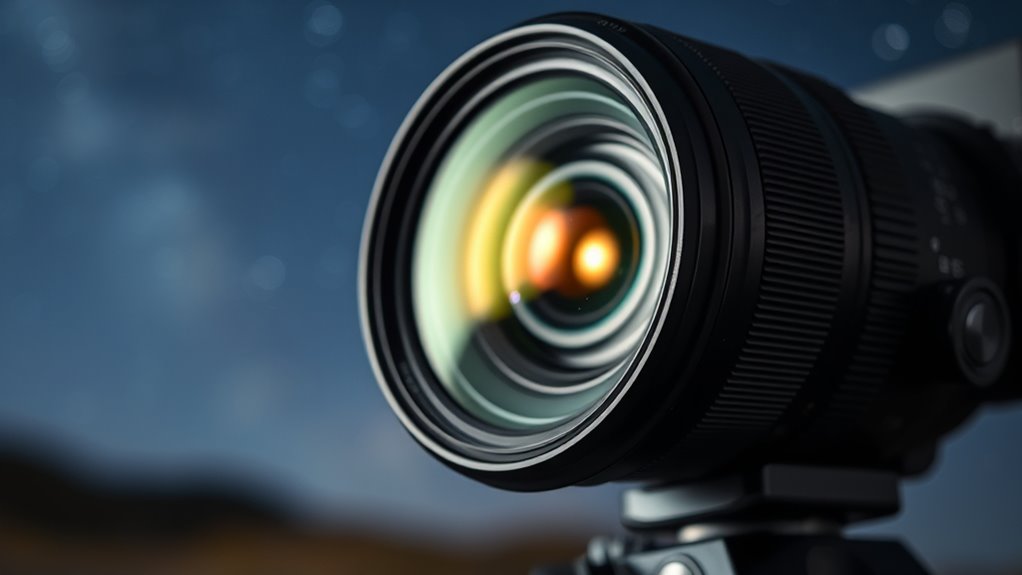
Focal reducers are often praised for their ability to shorten the focal length of your telescope, but they also have the potential to address certain optical issues like coma and field curvature. While they provide some optical correction, they don’t eliminate these problems entirely. Instead, they can improve image sharpness across the field, especially at the edges. Coma, which causes star images to appear comet-like, can be reduced, leading to crisper star points. Similarly, field curvature can be minimized, resulting in a flatter, more uniform image plane. However, relying solely on a focal reducer might not fully correct severe optical issues. For ideal image quality, it’s best to combine a focal reducer with other optical corrections or proper collimation.
All Focal Reducers and Flatteners Are Designed to Produce Perfect, Distortion-Free Images
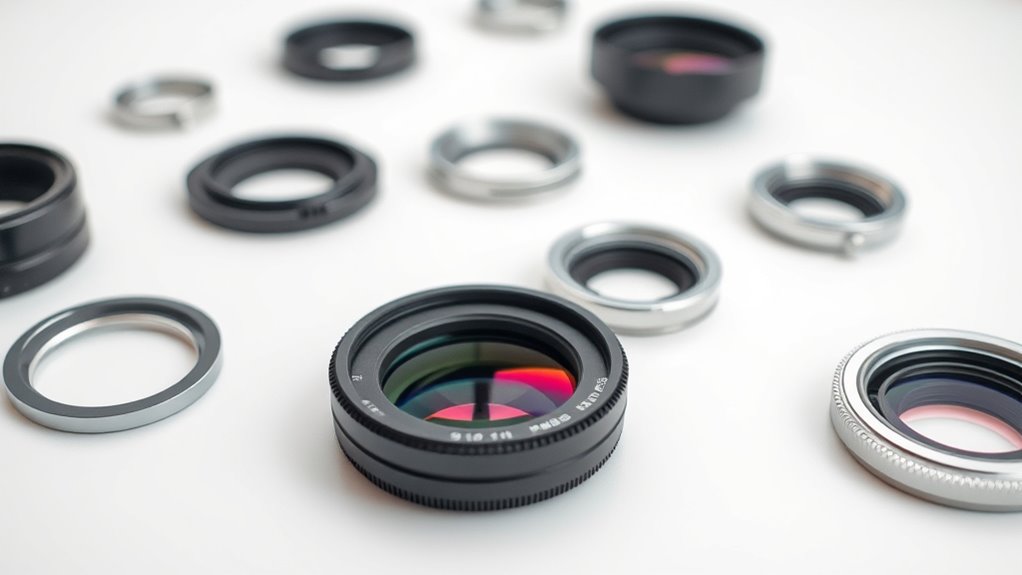
Many believe focal reducers and flatteners eliminate all distortions, but that’s not true. In reality, they can reduce certain issues, yet some distortion always remains due to design limits. Understanding these performance boundaries helps you set realistic expectations for your images.
Common Distortion Misconceptions
A common misconception is that all focal reducers and flatteners are designed to produce perfectly distortion-free images. In reality, some degree of distortion or optical imperfections can still occur, especially in wide-angle setups. These devices often help with vignetting correction and chromatic aberration, but they don’t guarantee flawless results. Additionally, understanding the limitations of AI in entertainment can help users set more realistic expectations when utilizing these optical tools.
Real-World Performance Limits
While focal reducers and flatteners are engineered to produce perfectly distortion-free images, achieving absolute perfection in real-world conditions is virtually impossible. You’ll encounter challenges like residual chromatic aberration that even advanced designs can’t fully eliminate. Vignetting correction may help, but uneven brightness can still diminish image quality. Manufacturing tolerances and lens alignment issues introduce subtle distortions that are hard to remove completely. Environmental factors, such as temperature and humidity, can also affect performance. Additionally, best dog training guides emphasize the importance of understanding equipment limitations to optimize results.
They Can Be Used Effectively Without Understanding the Specific Optical Characteristics of Your Setup
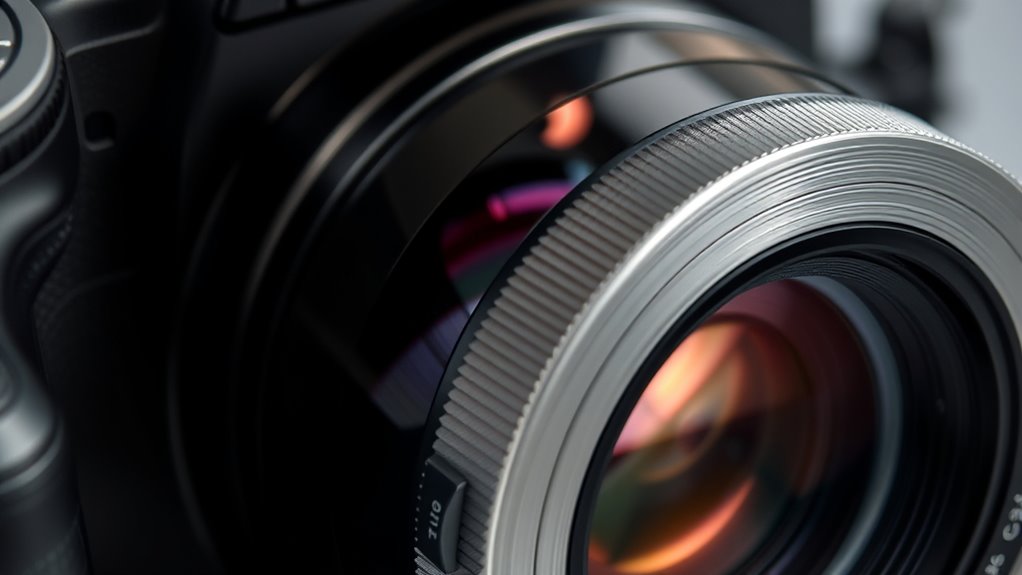
Even though focal reducers and flatteners can seem straightforward to use, relying on them without understanding your optical setup often leads to subpar results. You might think they’ll fix all issues, but neglecting factors like optical alignment and maintenance requirements can cause image degradation or uneven field curvature. Without knowing your system’s specific optical characteristics, you risk mismatched focal lengths or vignetting. Proper assessment helps you select compatible devices, minimizing aberrations. Additionally, understanding the optical properties of your setup ensures optimal performance and image quality.
The Main Purpose of These Devices Is Solely to Make the Telescope Smaller or More Portable
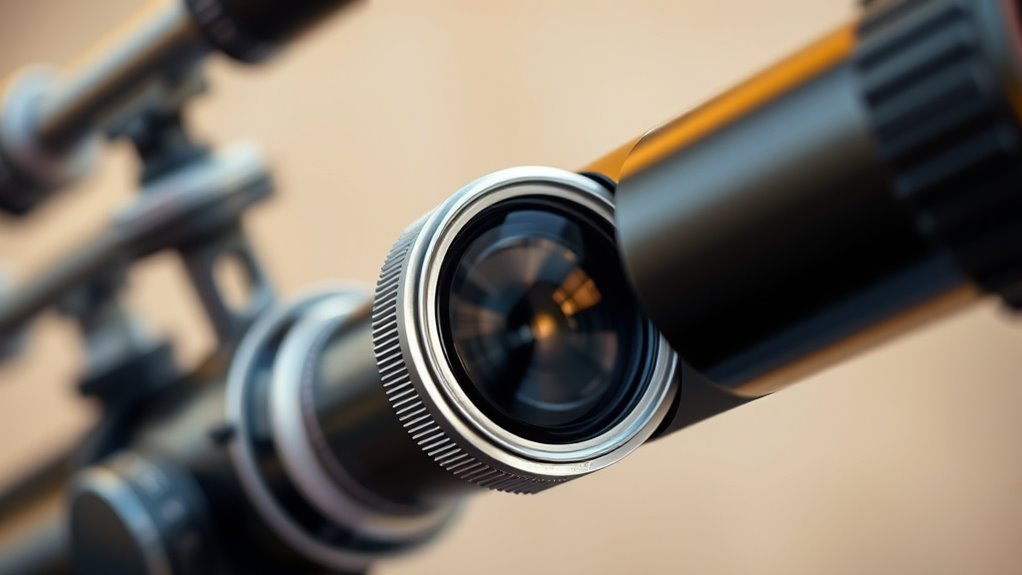
Many believe focal reducers and flatteners only make your telescope more portable, but they do much more. They can considerably improve image quality, expand your field of view, and enhance overall optical performance. Understanding these benefits helps you get the most out of your equipment.
Image Quality Enhancement
Although focal reducers and flatteners are often praised for making telescopes more portable, their primary purpose extends beyond just downsizing your equipment. They markedly enhance image quality by correcting optical issues and providing sharper, clearer views.
These devices help reduce chromatic aberration, which causes color fringing around objects, and minimize vignetting, the darkening at the image edges. They also:
- Improve overall field flatness for better star point focus across the entire image
- Increase brightness and contrast, making faint objects easier to observe
- Provide more consistent illumination across the field
- Enhance image sharpness, especially at the edges of the field of view
In essence, focal reducers and flatteners are tools for improving the clarity and fidelity of your observations, not just making your telescope smaller.
Field of View Expansion
Focal reducers and flatteners are often celebrated for their ability to make telescopes more portable, but their main advantage lies in expanding your field of view. By reducing the focal length, these devices increase the field of view, allowing you to see larger sections of the sky at once. This means you can capture more celestial objects in a single frame, which is especially useful for wide-field astrophotography or quick sky surveys. They also affect the image scale, making stars appear smaller and more spread out across the sensor or eyepiece. Instead of just making your telescope smaller or more manageable, focal reducers and flatteners profoundly improve your observational efficiency by broadening your view, giving you a more immersive and all-encompassing skywatching experience.
Optical Performance Focus
While making a telescope more portable and easier to handle is a benefit of focal reducers and flatteners, their primary purpose extends beyond just size reduction. These devices are designed to improve optical performance by reducing optical aberrations and enhancing image quality. They help minimize chromatic aberration, which causes color fringing around objects, and other distortions that compromise clarity.
- Correct field curvature to produce flatter images
- Reduce chromatic aberration for sharper stars
- Improve overall contrast and brightness
- Enhance focus accuracy across the entire field
Focal Reducers Are Only Useful for Astrophotography and Not for Visual Observing
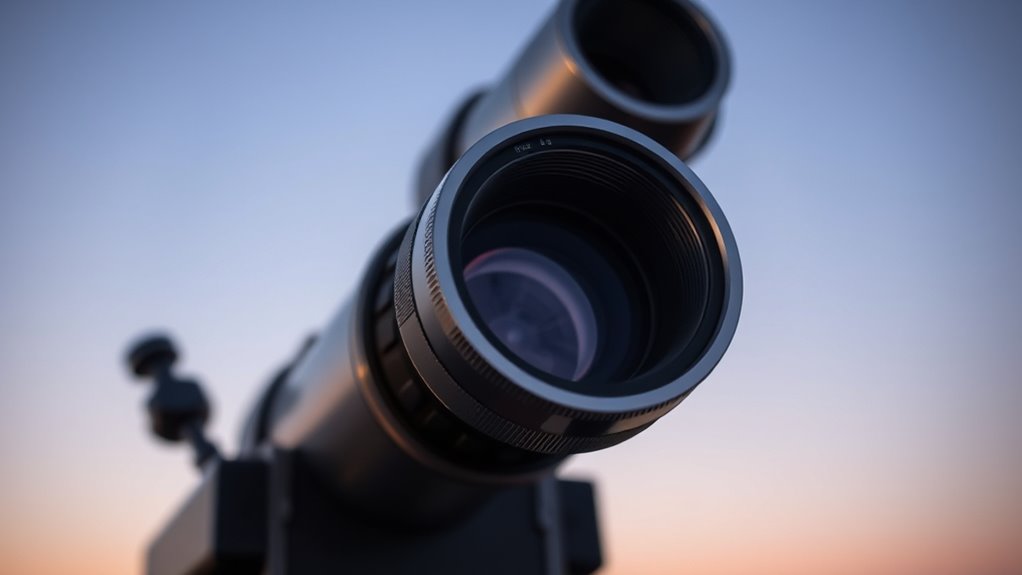
Many people assume that focal reducers are only beneficial for astrophotography, but this isn’t the case. If you’re into visual observation, especially planetary viewing, a focal reducer can enhance your experience. It widens the field of view, making it easier to scan the night sky and observe extended objects. For planetary observing, it can improve brightness and contrast, helping you see more detail with less eye fatigue. The reduced focal length also means faster exposure times when using your telescope visually, which can be useful in low-light conditions. Focal reducers aren’t just for capturing images; they can make your visual sessions more comfortable and immersive. So, whether you’re out under the stars for planetary detail or wide-field viewing, a focal reducer can be a valuable tool.
They Have No Impact on Image Scale or Magnification in Your Setup
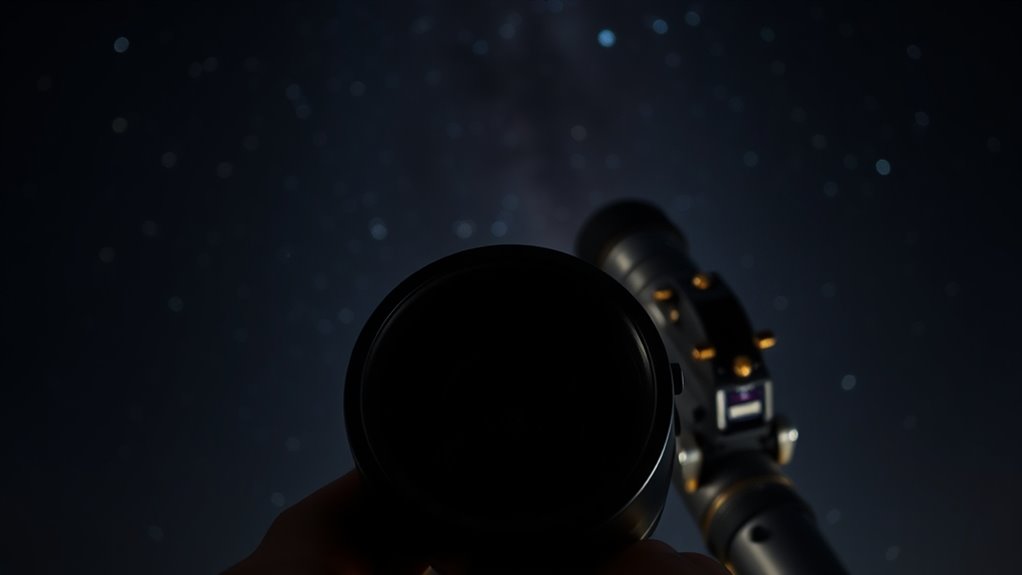
People often assume that using a focal reducer doesn’t change your image scale or magnification, but that’s not accurate. When you add a focal reducer, it actually decreases your telescope’s effective focal length, which impacts both image scale and magnification. This means:
- The image appears wider, showing more of the sky or scene.
- The apparent magnification diminishes because the focal length shortens.
- You get a larger field of view without changing your eyepiece.
- The overall image scale adjusts, making details appear less magnified.
Understanding this helps you better control your setup. Your focal reducer doesn’t just improve flatness or brightness; it also influences how much of the scene fits in your view and how large objects appear.
More Expensive Focal Reducers Always Deliver Better Image Quality
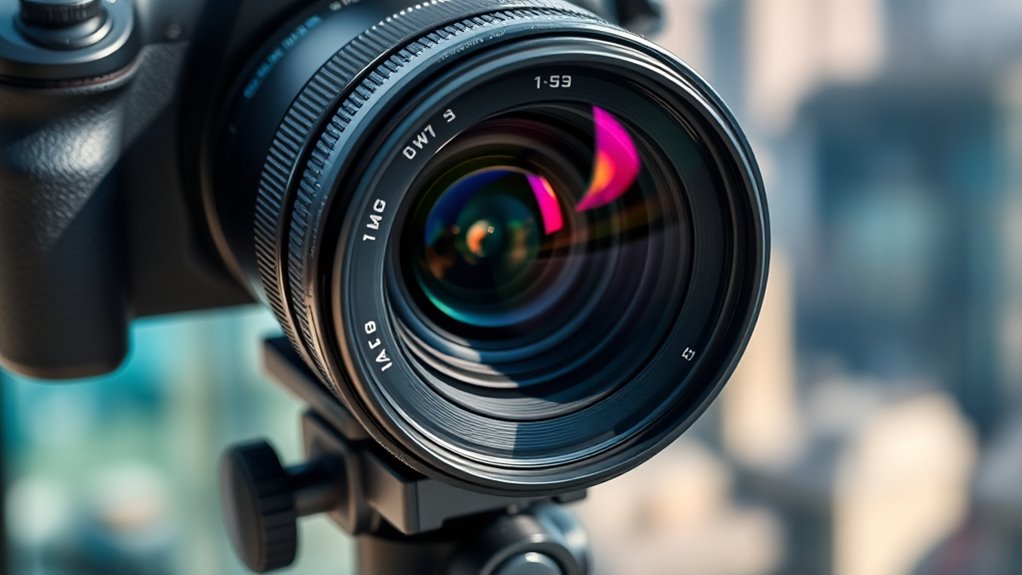
Investing in a more expensive focal reducer doesn’t automatically guarantee better image quality. Higher price tags often suggest superior craftsmanship, but they don’t always mean improved image brightness or better correction of optical distortions. In fact, some affordable focal reducers perform remarkably well, especially at certain focal lengths. While a pricier model might minimize aberrations and produce sharper images, it’s not a universal rule. Factors like coating quality, lens design, and your specific setup influence overall performance more than cost alone. Remember, choosing a focal reducer tailored to your telescope’s focal length and your imaging goals often yields better results than simply opting for the most expensive option. Cost doesn’t always equate to optical excellence.
Flatteners Are Only Necessary for Very Fast Telescopes or Specific Types of Imaging
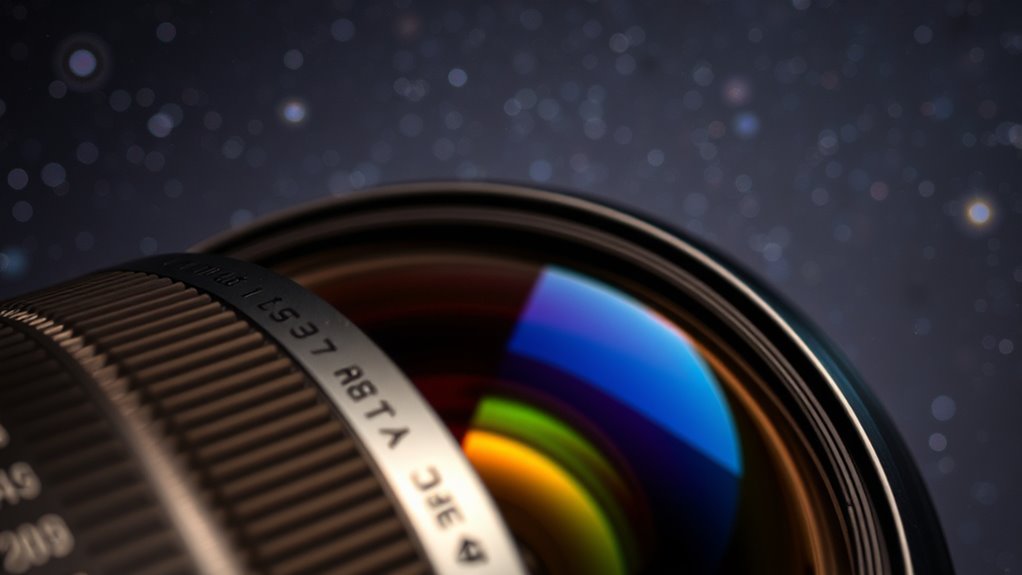
Many people believe flatteners are only needed for very fast telescopes or specialized imaging, but that’s not true. They have a broader application and can improve image quality in a variety of setups. Understanding when and why to use them helps you get better results, regardless of your telescope’s speed.
Narrow Application Scope
Flatteners are often thought to be necessary only for very fast telescopes or specialized imaging setups, but this isn’t entirely accurate. Their application limitations mean they aren’t always essential, especially given scope restrictions in many setups. You might assume flatteners are overkill outside high-speed optics, yet they can improve image quality in specific cases.
- They are rarely needed for slow refractors or standard astrophotography.
- Using them outside their scope can introduce unnecessary complexity.
- Application limitations mean they only benefit certain configurations.
- Overusing flatteners can lead to reduced image sharpness if misapplied.
Understanding these scope restrictions helps you avoid unnecessary equipment and ensures you only use flatteners where they truly make a difference.
Not Exclusive to Fast Telescopes
While flatteners are often associated with fast telescopes, their use isn’t limited to only those systems. Many believe flatteners are essential solely for telescopes with very fast focal ratios, but that’s a misconception. Flatteners can improve image quality across a range of telescopes, regardless of speed, by reducing field curvature and distortion. This broadens their compatibility, especially for wide-field astrophotography or imaging setups requiring sharp edges. The misconception that flatteners are only for fast scopes can lead to unnecessary limitations in your equipment choices. In reality, their application depends on your desired image quality and specific imaging needs rather than solely on the telescope’s speed. Understanding this helps you optimize your system without assuming flatteners are unnecessary for slower or moderately fast telescopes.
Once Installed, Focal Reducers and Flatteners Require No Ongoing Maintenance or Adjustments
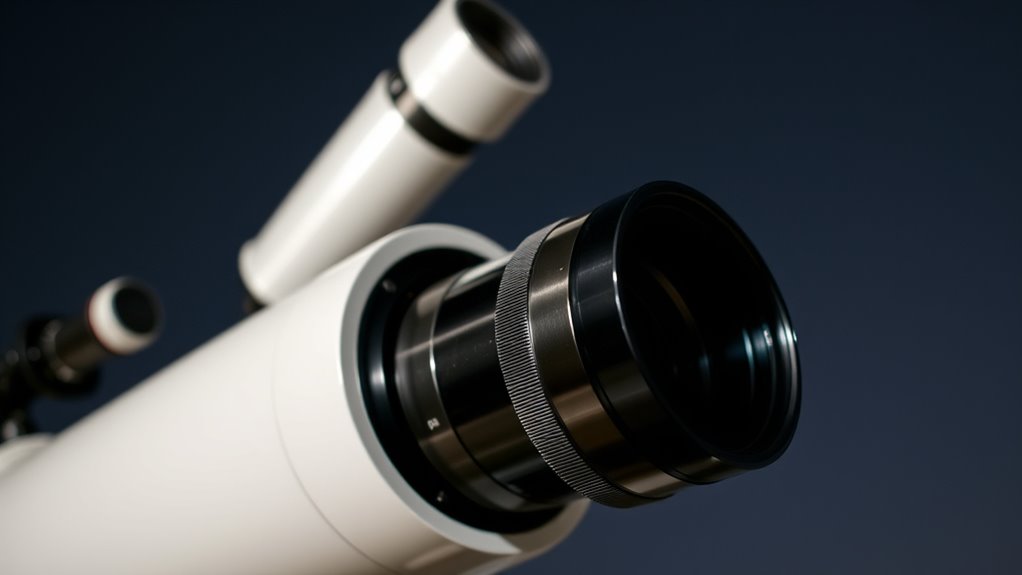
Once you’ve properly installed a focal reducer or flattener, it generally doesn’t require ongoing maintenance or adjustments. Many maintenance misconceptions and adjustment myths suggest you’ll need frequent tweaks, but that’s not true once everything is aligned. Proper installation ensures stability, so you can focus on capturing images instead of constant fiddling.
- The reducer or flattener stays aligned if mounted securely
- No regular calibration is needed after initial setup
- Adjustments are only necessary if you change the optical setup
- Maintenance involves simple cleaning of lenses and contacts
Frequently Asked Questions
Do Focal Reducers Affect Image Quality Across Different Telescope Types?
Focal reducers do affect optical performance and can introduce some image distortion, but their impact varies across different telescope types. Generally, they improve wide-field imaging and reduce focal length, making stars sharper at the edges. However, if not properly matched or quality-controlled, they can cause slight aberrations. You should select a focal reducer designed for your specific telescope to guarantee minimal image distortion and ideal performance.
Can Focal Reducers Improve Astrophotography Without Calibration?
Focal reducers can improve your astrophotography by enhancing lens correction and optical performance, but they can’t fully eliminate the need for calibration. While they help reduce aberrations and improve image sharpness, calibration remains essential for accurate, high-quality results. Without proper calibration, you might notice distortions or uneven star shapes, so use focal reducers as a tool to complement your calibration process rather than replace it entirely.
Are Flatteners Necessary for All Fast Telescopes?
Imagine your telescope as a finely tuned orchestra—flatteners are the conductor guiding harmony. You don’t always need flatteners for fast telescopes, but they’re essential if optical alignment struggles or chromatic aberration distorts your images. Without them, images may become warped or uneven. If your system is well-aligned and free of aberrations, you might get by without a flattener, but for consistently sharp, flat fields, they’re often worth the investment.
How Do Focal Reducers Influence Magnification and Field of View?
Focal reducers increase your field of view and decrease magnification change, making wide-angle shots easier. They effectively shorten your telescope’s focal length, allowing more of the sky to fit in your frame. As a result, your image becomes brighter and broader, ideal for capturing large celestial objects. Keep in mind, though, that they can slightly reduce image detail, so choose one based on your specific observing or imaging needs.
Do More Expensive Reducers Guarantee Better Imaging Results?
Imagine holding a crystal-clear lens that reveals every detail—expensive reducers often promise better imaging, but cost isn’t everything. You’ll find that brand reputation and build quality matter more than price alone. While higher-priced reducers can offer superior precision, some budget options deliver impressive results if crafted well. Focus on proven brands and reviews to guarantee your investment balances cost versus quality, giving you stunning images without unnecessary expense.
Conclusion
Don’t let misconceptions cloud your view of focal reducers and flatteners. They’re powerful tools, but not magic solutions—they have limitations and specific uses. Like a guiding star, understanding their true nature helps you navigate your astrophotography journey with confidence. Embrace knowledge over myths, and watch your images truly come alive. After all, isn’t the pursuit of clarity and truth what makes stargazing so endlessly mesmerizing?
